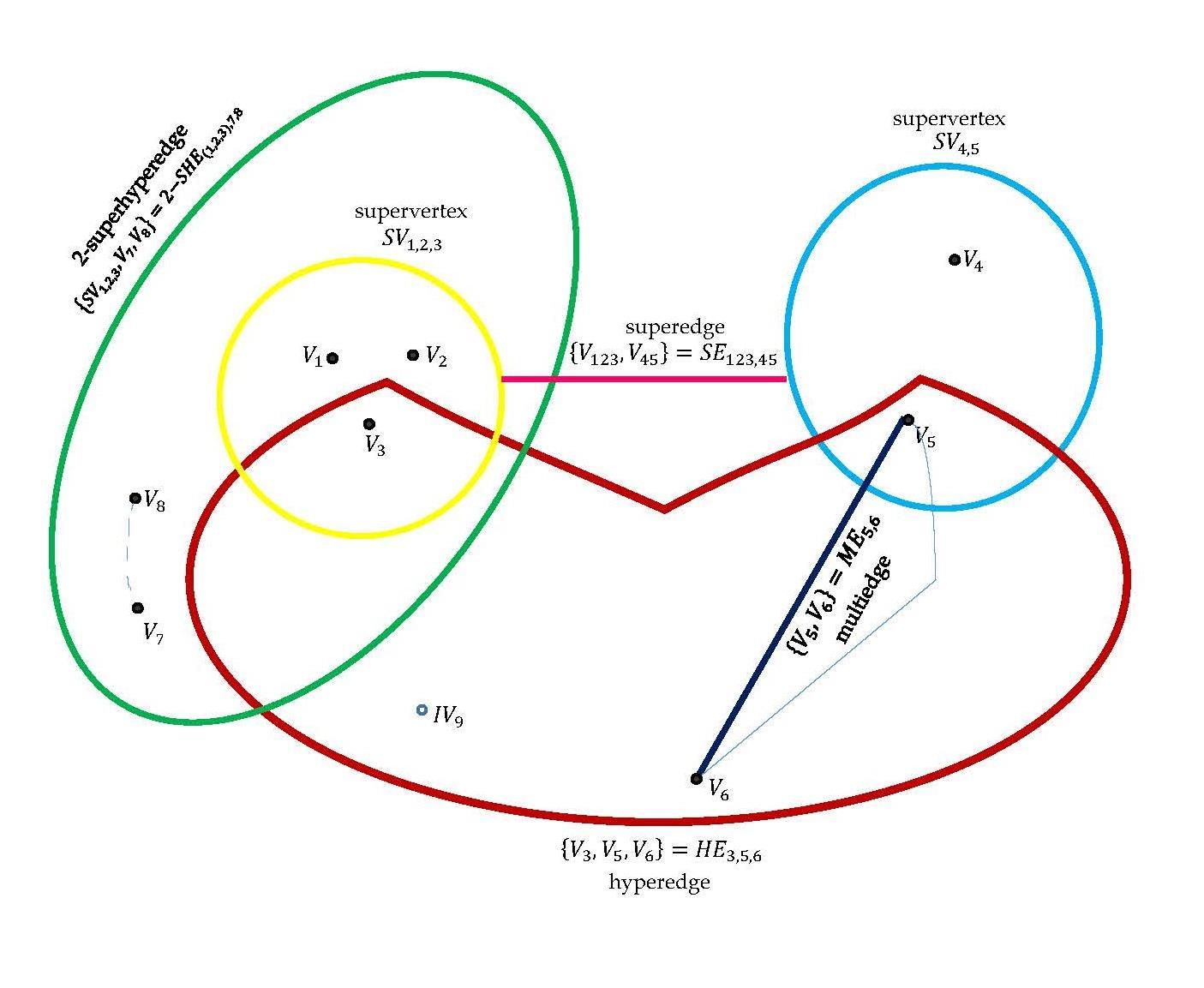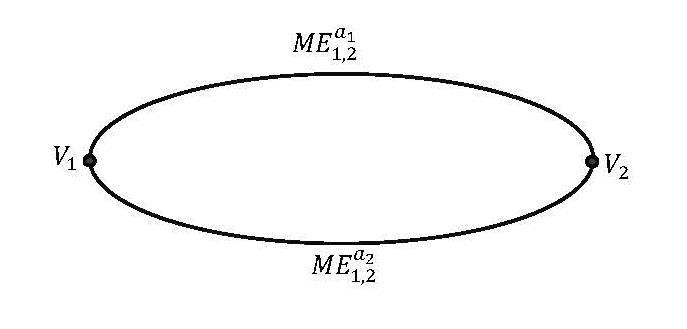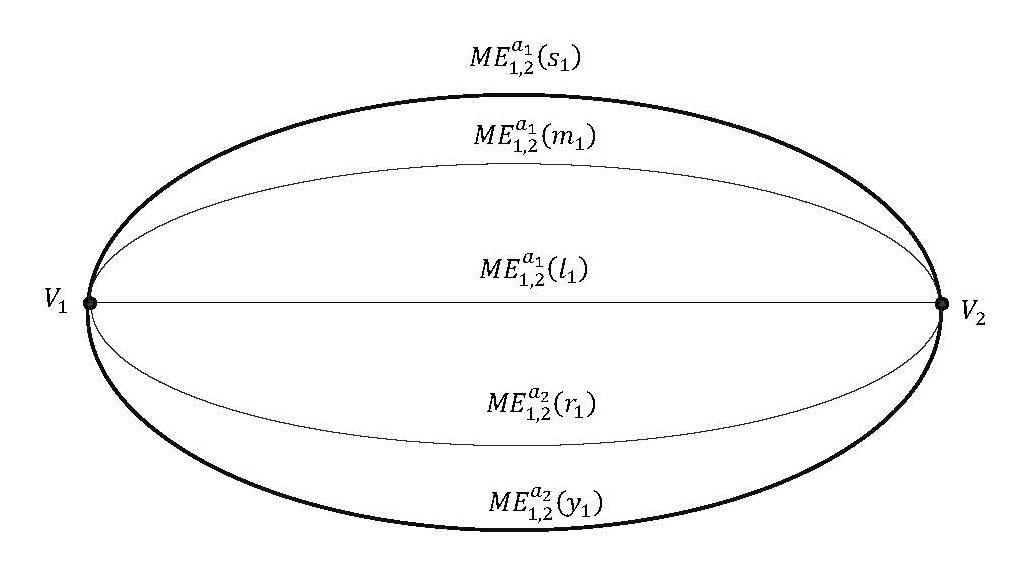Neutrosophic Sets and Systems, Vol. 33, 2020 University of New Mexico
Extension of HyperGraph to n-SuperHyperGraph and to Plithogenic n-SuperHyperGraph, and Extension of HyperAlgebra to n-ary (Classical-/Neutro-/Anti-)HyperAlgebra
Florentin Smarandache 1,*
1 University of New Mexico, 705 Gurley Ave., Gallup Campus, New Mexico 87301, United States

* Correspondence: smarand@unm.edu
Abstract: We recall and improve our 2019 concepts of n-Power Set of a Set, n-SuperHyperGraph, Plithogenic n-SuperHyperGraph, and n-ary HyperAlgebra, n-ary NeutroHyperAlgebra, n-ary AntiHyperAlgebra respectively, and we present several properties and examples connected with the real world.
Keywords: n-Power Set of a Set, n-SuperHyperGraph (n-SHG), n-SHG-vertex, n-SHG-edge, Plithogenic n-SuperHyperGraph, n-ary HyperOperation, n-ary HyperAxiom, n-ary HyperAlgebra, n-ary NeutroHyperOperation, n-ary NeutroHyperAxiom, n-ary NeutroHyperAlgebra, n-ary AntiHyperOperation, n-ary AntiHyperAxiom, n-ary AntiHyperAlgebra
1. Introduction
In this paper, with respect to the classical HyperGraph (that contains HyperEdges), we add the SuperVertices (a group of vertices put all together form a SuperVertex), in order to form a SuperHyperGraph (SHG). Therefore, each SHG-vertex and each SHG-edge belong to P(V), where V is the set of vertices, and P(V) means the power set of V
Further on, since in our world we encounter complex and sophisticated groups of individuals and complex and sophisticated connections between them, we extend the SuperHyperGraph to n-SuperHyperGraph, by extending P(V) to Pn(V) that is the n-power set of the set V (see below). Therefore, the n-SuperHyperGraph, through its n-SHG-vertices and n-SHG-edges that belong to Pn(V), can the best (so far) to model our complex and sophisticated reality. In the second part of the paper, we extend the classical HyperAlgebra to n-ary HyperAlgebra and its alternatives n-ary NeutroHyperAlgebra and n-ary AntiHyperAlgebra.
2. n-Power Set of a Set
Let U be a universe of discourse, and a subset V U. Let n ≥ 1 be an integer. Let P(V) be the Power Set of the Set V (i.e. all subsets of V, including the empty set and the whole set V). This is the classical definition of power set. For example, if V = {a, b}, then P(V) = {, a, b, {a, b} }. But we have extended the power set to n-Power Set of a Set [1].
Florentin Smarandache, Extention of HyperAlgebra to n-ary HyperAlgebra and n-ary (Neutro-/Anti-) HyperAlgebra, and Extension of HyperGraph to SuperHyperGraph and to Plithogenic SuperHyperGraph
For n = 1, one has the notation (identity): P1(V) ≡ P(V).
For n = 2, the 2-Power Set of the Set V is defined as follows:
P2(V) = P(P(V)
In our previous example, we get:
P2(V) = P(P(V) = P({, a, b, {a, b} }) = {, a, b, {a, b}; {, a}, {, b}, {, {a, b}}, {a, {a, b}}, {b, {a, b}}; {, a, b}, {, a, {a, b}}, {, b, {a, b}}, {a, b, {a, b}}; {, a, b, {a, b}} }.
Definition of n-Power Set of a Set
In general, the n-Power Set of a Set V is defined as follows: Pn+1(V) = P(Pn(V)), for integer n ≥ 1.
3. Definition of SuperHyperGraph (SHG)
A SuperHyperGraph (SHG) [1] is an ordered pair SHG = (G P(V), E P(V)), where
(i) V = {V1, V2, …, Vm} is a finite set of m ≥ 0 vertices, or an infinite set.
(ii) P(V) is the power set of V (all subset of V). Therefore, an SHG-vertex may be a single (classical) vertex, or a super-vertex (a subset of many vertices) that represents a group (organization), or even an indeterminate-vertex (unclear, unknown vertex); represents the null-vertex (vertex that has no element).
(iii) E = {E1, E2, …, Em}, for m ≥ 1, is a family of subsets of V, and each Ej is an SHG-edge, Ei ∊ P(V) An SHG-edge may be a (classical) edge, or a super-edge (edge between super-vertices) that represents connections between two groups (organizations), or hyper-super-edge) that represents connections between three or more groups (organizations), multi-edge, or even indeterminate-edge (unclear, unknown edge); represents the null-edge (edge that means there is no connection between the given vertices).
4. Characterization of the SuperHyperGraph
Therefore, a SuperHyperGraph (SHG) may have any of the below:
- SingleVertices (Vi), as in classical graphs, such as: V1, V2, etc.;
- SuperVertices (or SubsetVertices) (SVi), belonging to P(V), for example: SV1,3 = V1V3, SV2,57 = V2V57, etc. that we introduce now for the first time. A super-vertex may represent a group (organization, team, club, city, country, etc.) of many individuals; The comma between indexes distinguishes the single vertexes assembled together into a single SuperVertex. For example SV12,3 means the single vertex S12 and single vertex S3 are put together to form a super-vertex. But SV1,23 means the single vertices S1 and S23 are put together; while SV1,2,3 means S1, S2, S3 as single vertices are put together as a super-vertex. In no comma in between indexes, i.e. SV123 means just a single vertex V123, whose index is 123, or SV123 ≡ V123.
- IndeterminateVertices (i.e. unclear, unknown vertices); we denote them as: IV1, IV2, etc. that we introduce now for the first time;
- NullVertex (i.e. vertex that has no elements, let’s for example assume an abandoned house, whose all occupants left), denoted by V
Florentin Smarandache, Extention of HyperAlgebra to n-ary HyperAlgebra and n-ary (Neutro-/Anti-) HyperAlgebra, and Extension of HyperGraph to SuperHyperGraph and to Plithogenic SuperHyperGraph
- SingleEdges, as in classical graphs, i.e. edges connecting only two single-vertices, for example: E1,5 = {V1, V5}, E2,3 = {V2, V3}, etc.;
- HyperEdges, i.e. edges connecting three or more single-vertices, for example HE1,4,6 = {V1, V4, V6}, HE2,4,5,7,8,9 = {V2, V4, V5, V7, V8, V9}, etc. as in hypergraphs;
- SuperEdges (or SubsetEdges), i.e. edges connecting only two SHG-vertices (and at least one vertex is SuperVertex), for example SE(13,6),(45,79) = {SV13,6, SV45,79} connecting two SuperVertices, SE9,(2,345) = {V9, SV2,345} connecting one SingleVertex V9 with one SuperVertex, SV2,345, etc. that we introduce now for the first time;
- HyperSuperEdges (or HyperSubsetEdges), i.e. edges connecting three or more vertices (and at least one vertex is SuperVertex, for example HSE3,45,236 = {V3, V45, V236}, HSE1234,456789,567,5679 = {SV1234, SV456789, SV567, SV5679}, etc. that we introduce now for the first time;
- MultiEdges, i.e. two or more edges connecting the same (single-/super-/indeterminate-) vertices; each vertex is characterized by many attribute values, thus with respect to each attribute value there is an edge, the more attribute values the more edges (= multiedge) between the same vertices;
- IndeterminateEdges (i.e. unclear, unknown edges; either we do not know their value, or we do not know what vertices they might connect): IE1, IE2, etc. that we introduce now for the first time;
- NullEdge (i.e. edge that represents no connection between some given vertices; for example two people that have no connections between them whatsoever): denoted by E .
5 Definition of the n-SuperHyperGraph (n-SHG)
A n-SuperHyperGraph (n-SHG) [1] is an ordered pair n-SHG = (Gn Pn(V), En Pn(V)), where Pn(V) is the n-power set of the set V, for integer n ≥ 1
6. Examples of 2-SuperHyperGraph, SuperVertex, IndeterminateVertex, SingleEdge, Indeterminate Edge, HyperEdge, SuperEdge, MultiEdge, 2-SuperHyperEdge
Florentin Smarandache, Extention of HyperAlgebra to n-ary HyperAlgebra and n-ary (Neutro-/Anti-) HyperAlgebra, and Extension of HyperGraph to SuperHyperGraph and to Plithogenic SuperHyperGraph
Figure 1. 2-SuperHyperGraph, (IE7, 8 = Indeterminate Edge between single vertices V7 and V8, since the connecting curve is dotted, IV9 is an Indeterminate Vertex (since the dot is not filled in), while ME5,6 is a MultiEdge (double edge in this case) between single vertices V5 and V6
Let V1 and V2 be two single-vertices, characterized by the attributes a1 = size, whose attribute values are {short, medium, long}, and a2 = color, whose attribute values are {red, yellow}. Thus we have the attributes values ( Size{short, medium, long}, Color{red, yellow} ), whence: V1(a1{s1, m1, l1}, a2{r1, y1}), where s1 is the degree of short, m1 degree of medium, l1 degree of long, while r1 is the degree of red and y1 is the degree of yellow of the vertex V1. And similarly V2 ( a1{s2, m2, l2}, a2{r2, y2} ). The degrees may be fuzzy, neutrosophic etc.
Example of fuzzy degree: V1( a1{0.8, 0.2, 0.1}, a2{0.3, 0.5} ).

Example of neutrosophic degree: V1( a1{ (0.7,0.3,0.0), (0.4,0.2,0.1),(0.3,0.1,0.1) }, a2{ (0.5,0.1,0.3), (0.0,0.2,0.7) } ).
Examples of the SVG-edges connecting single vertices V1 and V2 are below:
Figure 2. SingleEdge with respect to attributes a1 and a2 all together
Florentin Smarandache, Extention of HyperAlgebra to n-ary HyperAlgebra and n-ary (Neutro-/Anti-) HyperAlgebra, and Extension of HyperGraph to SuperHyperGraph and to Plithogenic SuperHyperGraph

Figure 3. MultiEdge: top edge with respect to attribute a1, and bottom edge with respect to attribute a2

Figure 4. MultiEdge (= Refined MultiEdge from Figure 3): the top edge from Figure 3, corresponding to the attribute a1, is split into three sub-edges with respect to the attribute a1 values s1, m1, and l1; while the bottom edge from Figure 3, corresponding to the attribute a2, is split into two sub-edges with respect to the attribute a2 values r1, and y1.

Depending on the application and on experts, one chooses amongst SingleEdge, MultiEdge, Refined-MultiEdge, Refined RefinedMultiEdge, etc.
7. Plithogenic n-SuperHyperGraph
As a consequence, we introduce for the first time the Plithogenic n-SuperHyperGraph. A Plithogenic n-SuperHyperGraph (n-PSHG) is a n-SuperHyperGraph whose each n-SHG-vertex and each n-SHG-edge are characterized by many distinct attributes values (a1, a2, …, ap, p ≥ 1). Therefore one gets n-SHG-vertex(a1, a2, …, ap) and n-SHG-edge(a1, a2, …, ap). The attributes values degrees of appurtenance to the graph may be crisp / fuzzy / intuitionistic fuzzy / picture fuzzy / spherical fuzzy / etc. / neutrosophic / refined neutrosophic / degrees with respect to each n-SHG-vertex and each n-SHG-edge respectively.
For example, one has: Fuzzy-n-SHG-vertex(a1(t1), a2(t2), …, ap(tp)) and Fuzzy-n-SHG-edge(a1(t1), a2(t2), …, ap(tp));
Intuitionistic Fuzzy-n-SHG-vertex(a1(t1, f1), a2(t2, f2), …, ap(tp, fp))
Florentin Smarandache, Extention of HyperAlgebra to n-ary HyperAlgebra and n-ary (Neutro-/Anti-) HyperAlgebra, and Extension of HyperGraph to SuperHyperGraph and to Plithogenic SuperHyperGraph
Neutrosophic Sets and Systems, Vol. 33, 2020 295
and Intuitionistic Fuzzy-n-SHG-edge(a1(t1, f1), a2(t2, f2), …, ap(tp, fp)); Neutrosophic-n-SHG-vertex(a1(t1, i1, f1), a2(t2, i2, f2), …, ap(tp, ip, fp)) and Neutrosophic-n-SHG-edge(a1(t1, i1, f1), a2(t2, i2, f2), …, ap(tp, ip, fp)); etc.
Whence we get:
8. The Plithogenic ( Crisp / Fuzzy / Intuitionistic Fuzzy / Picture Fuzzy / Spherical Fuzzy / etc. / Neutrosophic / Refined Neutrosophic ) n-SuperHyperGraph.
9 Introduction to n-ary HyperAlgebra
Let U be a universe of discourse, a nonempty set S ⊂ U. Let P(S) be the power set of S (i.e. all subsets of S, including the empty set and the whole set S), and an integer n ≥ 1. We formed [2] the following neutrosophic triplets, which are defined in below sections: (n-ary HyperOperation, n-ary NeutroHyperOperation, n-ary AntiHyperOperation), (n-ary HyperAxiom, n-ary NeutroHyperAxiom, n-ary AntiHyperAxiom), and (n-ary HyperAlgebra, n-ary NeutroHyperAlgebra, n-ary AntiHyperAlgebra).
10. n-ary HyperOperation (n-ary HyperLaw)
A n-ary HyperOperation (n-ary HyperLaw) * n is defined as:
*: n n S P(S), and 12,,..., n aaaS one has 12 *(,,...,) nn aaa P(S).
The n-ary HyperOperation (n-ary HyperLaw) is well-defined.
11 n-ary HyperAxiom
A n-ary HyperAxiom is an axiom defined of S, with respect the above n-ary operation * n, that is true for all n-plets of Sn
12. n-ary HyperAlgebra
A n-ary HyperAlgebra (S, * n), is the S endowed with the above n-ary well-defined HyperOperation * n
13. Types of n-ary HyperAlgebras
Adding one or more n-ary HyperAxioms to S we get different types of n-ary HyperAlgebras.
14. n-ary NeutroHyperOperation (n-ary NeutroHyperLaw)
A n-ary NeutroHyperOperation is a n-ary HyperOperation * n that is well-defined for some n-plets of Sn [i.e. 1212 (,,...,),*(,,...,)() n nnn aaaSaaaPS ], and indeterminate [i.e. 1212 (,,...,),*(,,...,) n nnn bbbSbbb indeterminate]
Florentin Smarandache, Extention of HyperAlgebra to n-ary HyperAlgebra and n-ary (Neutro-/Anti-) HyperAlgebra, and Extension of HyperGraph to SuperHyperGraph and to Plithogenic SuperHyperGraph
or outer-defined [i.e. 1212 (,,...,),*(,,...,)() n nnn cccScccPS ] (or both), on other n-plets of Sn
15. n-ary NeutroHyperAxiom
A n-ary NeutroHyperAxiom is an n-ary HyperAxiom defined of S, with respect the above n-ary operation * n, that is true for some n-plets of Sn, and indeterminate or false (or both) for other n-plets of Sn .
16. n-ary NeutroHyperAlgebra is an n-ary HyperAlgebra that has some n-ary NeutroHyperOperations or some n-ary NeutroHyperAxioms
17.
n-ary AntiHyperOperation (n-ary AntiHyperLaw)
A n-ary AntiHyperOperation is a n-ary HyperOperation * n that is outer-defined for all n-plets of Sn [i.e. 1212 (,,...,),*(,,...,)() n nnn sssSsssPS ].
18. n-ary AntiHyperAxiom
A n-ary AntiHyperAxiom is an n-ary HyperAxiom defined of S, with respect the above n-ary operation * n that is false for all n-plets of Sn
19. n-ary AntiHyperAlgebra is an n-ary HyperAlgebra that has some n-ary AntiHyperOperations or some n-ary AntiHyperAxioms
20. Conclusion
We have recalled our 2019 concepts of n-Power Set of a Set, n-SuperHyperGraph and Plithogenic n-SuperHyperGraph [1], afterwards the n-ary HyperAlgebra together with its alternatives n-ary NeutroHyperAlgebra and n-ary AntiHyperAlgebra [2], and we presented several properties, explanations, and examples inspired from the real world.
References
1 F. Smarandache, n-SuperHyperGraph and Plithogenic n-SuperHyperGraph, in Nidus Idearum, Vol. 7, second edition, Pons asbl, Bruxelles, pp. 107-113, 2019.
2. F. Smarandache, The neutrosophic triplet (n-ary HyperAlgebra, n-ary NeutroHyperAlgebra, n-ary AntiHyperAlgebra), in Nidus Idearum, Vol. 7, second edition, Pons asbl, Bruxelles, pp. 104-106, 2019.
Received: Mar 02, 2020. Accepted: May 02, 2020
Florentin Smarandache, Extention of HyperAlgebra to n-ary HyperAlgebra and n-ary (Neutro-/Anti-) HyperAlgebra, and Extension of HyperGraph to SuperHyperGraph and to Plithogenic SuperHyperGraph
